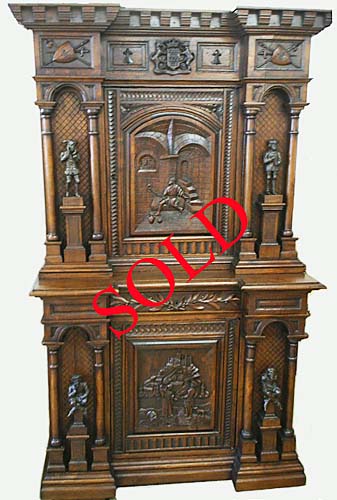
This two-piece cabinet has come to mystify and delight us as we sought to uncover the story behind the two narrative panels and the heraldic symbols it displays.
Its overall structure owes much to the Gothic Revival movement in 19th century France, in terms of the use of architectural elements such as crenellations, arches, mouldings, columns and pedestals.
Yet with a nod to Renaissance Revival and the so-called Second Renaissance of the 16th century in France, it includes two large panels depicting scenes incorporating perspective and landscape, along with four statuettes, and armorial symbols such as the distinctive ermine tail associated with the Duchy of Brittany.
Our greatest challenge with this piece has been to uncover the story from the central panels incorporated in the doors of the upper and lower pieces of the cabinet.
The ermine tails and motto from the crest atop the upper section ultimately proved the key to unlocking the symbolism of this cabinet.
For a more detailed explanation of the story we believe it commemorates, see The War of the Breton Succession below the photographs on this page.
Stylistically, this meuble breton mimics a castle with crenellations in its overall, solid construction. Broken down into upper and lower sections, each has a central door and niches on either side inhabited by statuettes. The lower section has one drawer above the door. The doors and drawers all lock with the same key.
The upper section has an elaborate moulding to suggest the towers of a medieval castle. Below the moulding are repeated heraldic elements: ermine tails and shields bearing fleur-de-lis placed atop crossed swords. In the center is a crest consisting of a crown atop a shield covered in ermine tails and flanked by mastiffs rampant, below which is a partial motto, quam faedari. We cannot explain why the left side of the area for the motto is blank except that there were several possible versions of the text preceding "quam faedari." The crest comprised of ermine tails below a crown is traceable directly to the chivalric Order of the Ermine created by Jean IV Duke of Brittany in 1381. For more about the origins of the motto and the heraldic symbolism, see the text below the photos.
We are at a loss to explain the mastiffs rampant on the crest and the presence of the dog in the scene depicted on the door panel of the lower section of the cabinet. While it was not uncommon to use dogs in heraldry, especially mastiffs who symbolized courage, vigilance, and loyalty, we have not located a coat-of-arms such as this. But, we suspect that whoever commissioned the cabinet had roots in the Breton nobility and a love of canines.
We believe that the shields with the fleur-de-lis atop the crossed swords on either side of the front of the top section bear witness to the conflict between the Duchy of Brittany, symbolized by the ermine tails, and the Kingdom of France, symbolized by the >fleur-de-lis, with the Kingdom ultimately annexing the Duchy in 1378.
Despite all the intricately carved decorative elements, the focus of attention for this cabinet is the two narrative scenes — on the central door of the top and of the bottom sections of the cabinet. Although oak, which does not lend itself to fine detail as readily as walnut, the carving is exceptional in depicting two scenes and creating a sense of three-dimensionality and deep perspective.
The panel on the upper section shows a prisoner, chained to the wall of a vaulted cell with a tiny window and tinier door atop a small staircase. The architectural detail of the vaulting is wonderfully Gothic and evokes the atmosphere of a dank dungeon. Through the barred window of the cell, a person peers with interest at the prisoner who returns his or her gaze. The balance and symmetry of the panel with the central focus on the chained prisoner is compelling. As discussed in The War of the Breton Succession below the photos on this page, we believe the scene depicts the brief imprisonment of Jean de Montfort, pretender to the throne of Brittany, and that he is gazing back at his wife, Jeanne la Flamme, who peers through the window at him.
The door panel of the lower section of the cabinet depicts a scene of two figures and a dog standing in the foreground with a hillside fortress behind them. We believe that the figure on the left is a monk or abbot with Jean IV Duke of Brittany on the right, commemorating the founding of a chapel (and later a monastery) on the site of the final battle in the War of the Breton Succession fought below the Castle of Auray. While at least one engraving and one illumination exist showing the fortress of Auray, we suspect that the 19th century designer of this cabinet did not have access to them and therefore created from his imagination the scene of the establishment of the monastery at Auray.
While interesting and highly decorative, we do not believe the statuettes on pedestals, on either side of the central panel of the upper section, are original. They are easily removed from their pedestals and their costume is Renaissance in style rather than Gothic. Moreover, the scale and the style of the carving does not match the statuettes from the lower section which appear to be jesters or dramatic figures one would expect to find at a medieval court.
Overall, the cabinet is in very good condition, considering its age. Because of its massive proportions, it has developed several splits which have been repaired. The largest is not visible because it is on the horizontal surface of the bottom section upon which the top section sits.
Finally, we note that it has been difficult to photograph the cabinet and obtain consistent coloration while highlighting the details of the carving - whether with or without flash. Therefore, we remind visitors to this site that the color of the cabinet is consistent and matches most closely the coloration of the photo at the top of this page. However, in order to show the beauty and intricacy of the carving, certain photos make the wood appear lighter than the natural appearance of the cabinet.
Reference
Boccador, Jacqueline, Le Mobilier Français du Moyen Age à la Renaissance (Editions d'Art Monelle Hayot, Saint-Just-en-Chaussée, 1988); Bonnaffé, Edmond, Le Meuble en France au XVI Siècle (Librairie de l'Art, Paris, 1887); Bos, Agnès, Mobilier du Moyen Age et de la Renaissance — La Collection du Musée du Louvre (Editions du Musée du Louvre/Somogy, Paris, 2019); Piat, Florence, Les stalles de l’ancien duché de Bretagne, (L'Université Européene de Bretagne, Rennes, 2012); Thirion, Jacques, Le Mobilier du Moyen Age et de la Renaissance en France (Editions Faton, Dijon, 1998); Viollet-le-Duc, Eugène, Le Mobilier Médiéval (Georges Bernage, editor) (Editions Heimdal, 2003)
Uses
This cabinet is meant to be viewed and admired; claiming pride of place in whatever room it is installed.
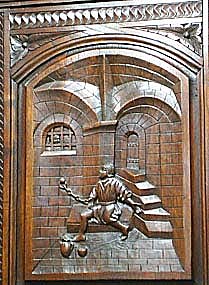
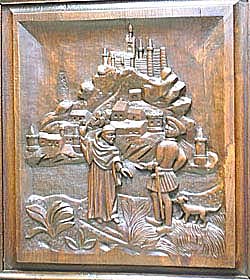
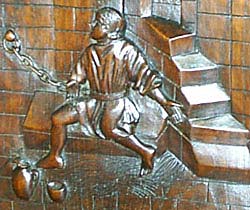
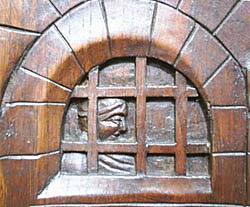
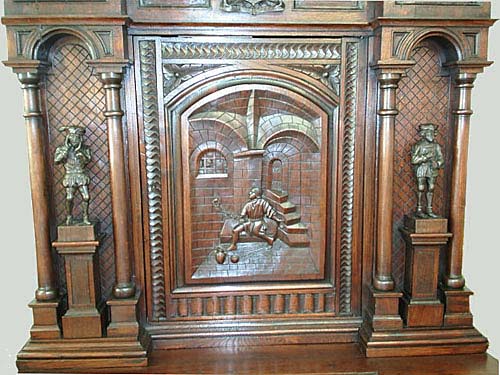
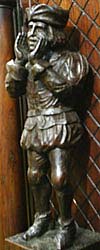

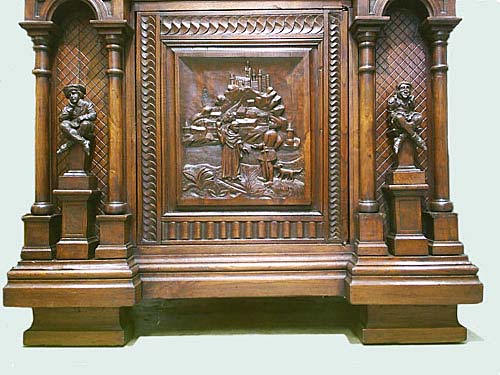
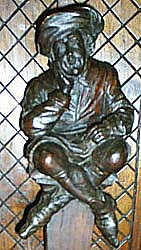
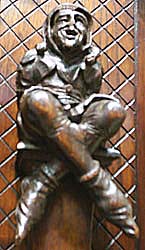
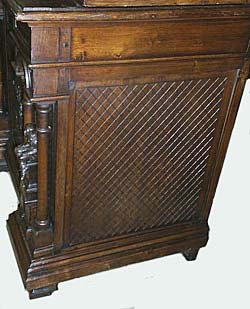
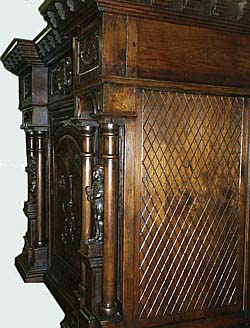
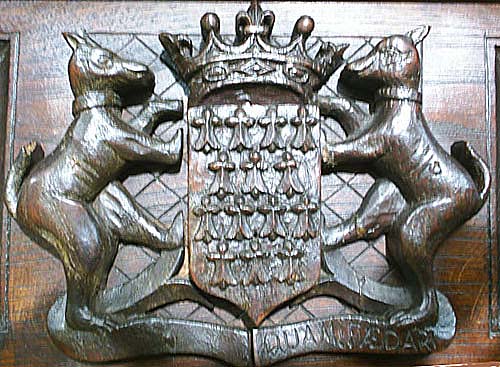
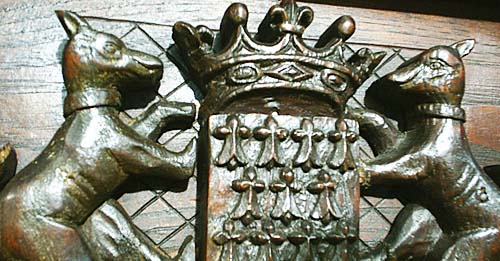
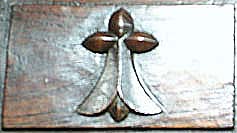
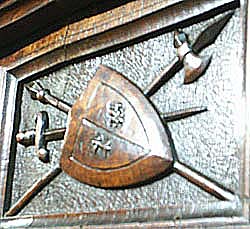
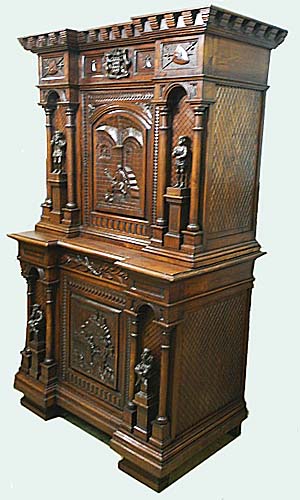
The War of the Breton Succession
Caught up in the larger conflict of the 100 Years War between France and England (1337-1453), the battle for succession to the Duchy of Brittany is a subset of a larger conflict but battered by the same forces - bloodlines, money, land, strategic marriages, and the feudal system of loyalties and obligations. It is also a bit confusing, owing to the two Jeans at the center of our story, father and son, who at times are both referred to as Jean IV. This is where other appellations, such as "the Conqueror," "the Valiant," and "the Wise" come in handy in keeping the dramatis personae straight.
The seeds of our story were planted when Jean III, Duke of Brittany (called "The Good") died without issue in 1341. Jean III had attempted to ensure the duchy would pass to his niece, Jeanne de Ponthièvre. She was married to Charles de Blois, the successor favored by the King of France who was interested in annexing Brittany and gaining access to its wealth and to the feudal services of its nobility. But Jean III's half-brother, also named Jean but known as Jean de Montfort and sometimes as Jean IV, believed the duchy should pass to him and ignited what is known as the War of the Breton Succession. Jean de Montfort was supported in his quest by the English, who at the time held territory in Southwestern France and were looking to further their claims to the throne of France. Either way, the Bretons were hoping to remain independent.
Brittany became a battleground between the two rival groups headed by Jean de Montfort and his son, Jean, and by Charles de Blois and, later, Bertrand du Guesclin, with troops laying siege to towns and cities throughout the duchy. Jean de Montfort was taken prisoner briefly and sent to Paris in 1342. During his imprisonment, his wife, Jeanne de Flandres, also known as Jeanne la Flamme, became the heroine of her husband's cause. Holding her young son, Jean, in her arms, Jeanne exhorted the people of Hennebont to resist the attack of the forces of Charles de Blois and rode her horse at the head of 300 troops, leading them to victory with what was described as the courage of a man and the heart of a lion. Her husband died in 1345 at Hennebont, having fallen ill during the siege of Quimper.
Jean son of Jean de Montfort and Jeanne la Flamme, but also known as Jean de Montfort, followed in the family tradition of conflict and valor, still fighting Charles de Blois. On September 29, 1364 outside the ramparts of Auray Castle, Jean de Montfort crushed those forces with the help of an army provided by the Black Prince (heir to the throne of Edward III of England) who was his brother-in-law at the time. Charles de Blois died on the field of battle and his ally Du Guesclin was taken prisoner. The Battle of Auray effectively ended the war of succession with Jean de Montfort's accession cemented by the Peace of Guérande in 1365 by which he became, officially, Jean IV Duke of Brittany (also known as Jean "the Conqueror" and Jean "the Valiant").
By all accounts the Battle of Auray was an emotionally-charged victory for Jean IV who wept upon finding the body of his distant relative and rival, Charles de Blois. Jean erected a chapel at Auray dedicated to the Archangel Saint Michael on whose day the battle was fought and later established a collegiate church there which became a Carthusian monastery.
Subsequent exploits of Jean IV bring us back to the story of this cabinet and the symbolism in the heraldic motifs. In 1381, Jean IV established the Order of the Ermine as a means of affirming his preeminence over the Breton nobility and creating a sense of unity as their sovereign, despite King Charles V of France having annexed the duchy, weakened and impoverished by years of conflict, in 1378. Unlike other chivalric orders such as the Knights of the Garter created by King Edward III of England, the Order of the Ermine was open to women and commoners, not just to male nobles. Symbolism of the Order included a crest of ermine tails below a crown and the motto including the words potius mori, quam faedari (or foedari) translated into French as plutôt mourir que se souiller or à ma vie, plutôt mourir. The motto has been translated into English variously, including "death before dishonor" and "better dead than sullied." It is linked to the ermine through the legendary belief that the weasel whose coat turns white in winter (but for its black tail) would prefer death over the possibility dirtying its coat by crossing a marsh. The legend of the ermine has also been linked to the medieval cult of the Virgin Mary and belief in the Immaculate Conception.
This motto was set in stone during the 15th century above the south porch of the Basilica of Folgoët in Brittany where ermines are shown encircled by bands bearing the motto. Although the construction of the Basilica is more closely associated with Duke Jean V (son of Duke Jean IV and also known as Jean "the Wise"), the motto stems from the Order of the Ermine created by his father, Jean IV.
Based on the foregoing, we believe that the scenes depicted on the door panels of the cabinet relate to Jean de Montfort and his son, Jean IV Duke of Brittany. We believe the top panel shows Jean de Montfort imprisoned while his wife, Jeanne la Flamme, looks through the prison window on her way to lead the troops relieving the siege of Hennebont. The bottom panel shows a robed figure and a nobleman in the foreground with a hilltop village in the distance. We believe this scene depicts the founding of the chapel dedicated to Saint Michael by Jean IV, triumphant at the battle fought below the Castle of Auray.
While there are others linked to Brittany who spent time in prison, such as Charles de Blois and Bertrand de Guesclin, they were on the side of the King of France and their exploits would likely not be memorialized on a cabinet replete with so much Breton symbolism. Other famous prisoners come to mind, from Richard I the Lionheart, to the Count of Monte Cristo, but lacking a connection to Brittany. There is even the 18th century revolutionary Pierre Victurnien Vergniaud who used a similar motto but was from Gironde, without any apparent connection to Brittany. Based on our research, we continue to believe that the most likely story is that of Jean de Montfort, Jeanne la Flamme and their son Jean IV the Conqueror.